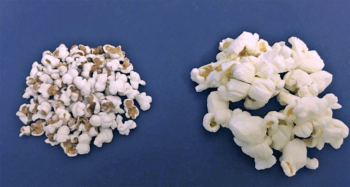Popped Sorghum Making Its Way Onto Snack Scene

Orville Redenbacher might not have envisioned grain sorghum in his air poppers, but the niche snack is finding its way onto U.S. grocery shelves, and a Texas A&M AgriLife Research program is conducting research into the genetic inheritance of popping in grain sorghum.
Dr. Bill Rooney, an AgriLife Research sorghum breeder in College Station, has been studying the human benefits of the phytochemicals in sorghum for many years, and his research into popped sorghum is a result.
Worldwide, sorghum is a human food, but in the U.S., it is used primarily as livestock feed.
Rooney said while popped sorghum has been consumed in certain cultures for generations, it has not had the amount of selective breeding that popcorn has. His team is now seeking heritable traits in sorghum lines associated with popping quality.
Nicholas Pugh, a graduate student under Rooney, evaluated 130 lines of sorghum derived from a hybrid of two known varieties with popping characteristics. Grain from each line was produced in Weslaco, Corpus Christi and Halfway just north of Lubbock. From these samples, 500 seeds were counted and popped.
“We want to determine what the relative influence of genotype, environment, and genotype by environment effects were on popping quality,” he said. “We wanted to determine how heritable popping quality is in sorghum. Finally, we wanted to identify quantitative trait locations.”
Continue reading on AgriLife Today.
This article by Kay Ledbetter originally appeared in AgriLife Today.





